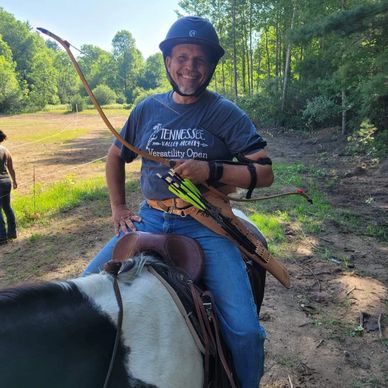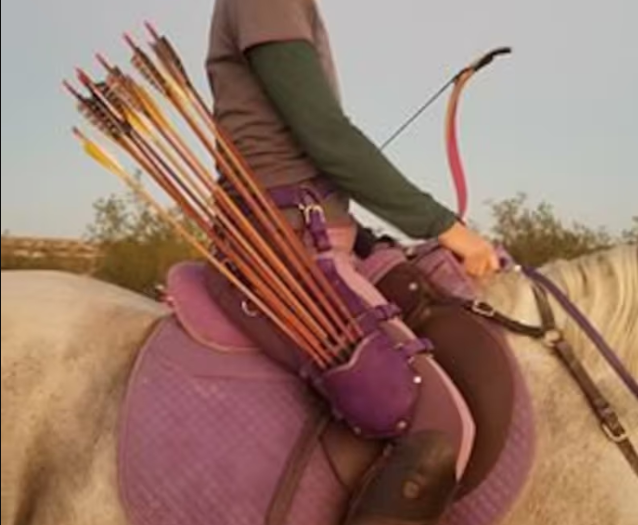Mounted Archery
Equipment
Needed Equipment for Horseback Archery
There are only three things you really need in order to do mounted archery: a horse, a bow, and some arrows.
However, not just any bow and arrows will work. Plus, there are some additional accessories that will not only make your life easier, but also help keep you safe so you can just focus on having fun.
Check out the list of mounted archery equipment below to see my recommendations for what you’ll need to get started.
Jump to:
Horse Archery Bows
The only requirements for horse archery bows is that they must be traditional bows. This means no wheels, pulleys, cams, multiple cables, or arrow shelves — which means no compound bows and no modern recurve bows.
Other than the fact that the bow must be traditional, there are typically no other rules related to the bow. You can have any draw weight on your bow and any style (Turkish, Hungarian, etc).
However, can and should are two very different things.
Finding a Bow that Fits
First of all, shorter bows are generally preferred as they are easier to maneuver with when on horseback.
Second, you’ll want a mounted archery bow with a good draw weight for you (Draw weight refers to how hard it is to pull the string back). The higher the draw weight, the faster and further the arrow would go, but the harder it will be to pull.
For reference, I’m a young adult, female, with little to no upper body strength and prefer my 20lb bow. I also have a 28lb and can pull it, but I will tire out quickly when using that bow and can not fire it as quickly (which is important for mounted archery). However, I wouldn’t go below 15lbs for fear that you might start struggling to get your arrows to reach the targets.

If possible, I would recommend stopping in your local archery shop to try out a few different bows with different draw weights. If you can’t decide between two draw weights, I would go with the lighter option. A bow that has too high of a draw weight for you will quickly lead to frustration and tends to cause people to give up on the sport.
I personally use a 20lb Crimean Tatar bow. I’ll be perfectly honest, I didn’t chose the bow for any particular specs or performance advantages. It was the only type of bow that my instructor had available when I first started learning mounted archery, and I liked it, so I stuck with it.
Where to Buy a Horseback Archery Bow
Alibow is a popular place recommended to me by other mounted archers for buying mounted archery bows. Unfortunately though, it’s based in China. They have fantastic quality bows. It can just take a while to arrive in the United States. However, there are a few archery shops in the United States that import them on a regular basis and keep them in stock. You probably won’t save any money between ordering from Alibow or ordering from a US archery shop, but you’ll probably receive the bow sooner if you order from a US-based archery shop. Personally, I got my bow from Tennessee Valley Archery.
Arrows for Mounted Archery
Obviously, a bow isn’t much use without arrows. Actually, it’s really bad for the bow if you pull the string and let go without an arrow on it (referred to as dry firing). Dry firing a bow can cause the bow to break — even shatter. Given that the bow is one of the more expensive pieces of equipment on this list, dry firing your bow can hurt the bank (not to mention the archer).
Despite the firm rule about needing a traditional bow, you DON’T need traditional wooden arrows (although you can get arrows that look wooden if you want that traditional looking aesthetic). Actually mounted archers rarely use traditional wood or bamboo arrows because it’s hard to make multiple arrows exactly the same — meaning some of your arrows might fly a little different than others which makes it hard to be consistent and accurate (two key components to being successful in this sport).
When it comes to arrows, you can get really in depth with choices. For those just getting into archery, there are two main things I would look for in arrows — they’re made of carbon or aluminum, and have feather fletchings instead of plastic.
Feathered Fletchings

Plastic Fletchings

Before I got into mounted archery, I purchased Black Eagle’s vintage arrows (carbon arrows that look like wood) to use for my modern recurve bow, so I often just use those for mounted archery competitions.
However, for those just starting out, I generally recommend getting something on the cheaper side. When first starting — you’re going to miss the target, which means that you’re going to loose and break arrows relatively frequently. It’ll be easier on the bank if you start out with cheaper arrows and then upgrade to nicer ones as your skills improve.
For those just get started, I usually recommend these arrows: TTFLY FLETCHING TTAD
Horse Archery Quivers
You’re going to need something to hold the arrows you’re not actively shooting — that’s where a quiver comes in! However, unfortunately not just any quiver will do. Most quivers you’ll find online are designed for field and target archers. The quiver attaches at the hip and hangs loose at the archers side, and they have tubes that you can put multiple arrows into.
The arrows being loose in the tubes is what makes these quivers a particularly bad choice for mounted archery. Unlike ground archery where the archer is still, the movement of a horse would potentially cause the arrows to bounce out of a traditional field or target quiver, which could potentially spook or even injure the horse.
Quivers designed specifically for mounted archery will typically have a slot for each individual arrow that keeps the arrow securely in the quiver (but still loose enough for you to pull out in a hurry). Mounted archery quivers also come in various styles: front and hip/thigh.

Front quivers attach to the archer’s waist and generally rest with the arrows coming across the front of the body.

Hip/thigh quivers have a strap that goes around the archers waist, and one that goes around the thigh, with arrows pointing backwards.
Where to Purchase Mounted Archery Quivers
Leatherworking is a hobby of mine, so I made my own quiver (it was actually one of my very first leatherworking projects), and unfortunately I generally don’t do leatherworking commissions (it would take me 8+ months for me to complete it and it’s just not worth the wait for you).
Some of the mounted archers I’ve met got their quivers from Knavish Designs on Etsy, who makes a couple of different style hip/thigh quivers. Unfortunately she is based in Australia, so it can sometimes take a bit for orders to arrive.
Other recommended mounted archery quiver makers include:
Rein Keeper
While not a required piece of equipment, this is something I generally recommend to all those starting their mounted archery journey. Shooting a bow requires both hands, which means that you have to let go of the reins. The last thing you want is for your reins to slip out of reach, or worse, over the horse’s head. Rein keepers attach to your reins and the saddle so you can safely let go of the reins and know that they’ll be in reach in the event you need them.
The Booma Rein Keeper can be bought from many online tack stores as well as Amazon. However, many mounted archers I know prefer to make their own or buy them from artisans on Etsy.
Arm Guards & Hand Protection
Some additional safety equipment you’ll ideally want to have include:
- Something to protect your bow arm (arm guard)
- Something to protect the hand your arrow rests on (bow hand glove)
- Something to protect the fingers you use to shoot (thumb ring or finger tab/glove)
Like riding helmets, the above listed equipment is all designed to help protect the archer. However, it’s not uncommon to see archer’s choose to forgo this equipment in lieu of comfort. However, I recommend all new archers use this equipment for their safety.
Arm Guards
When shooting a bow, it’s possible for the string of the bow to slap your arm when you release. Imagine your older sibling snapping you with a rubber band when you weren’t expecting it and then multiply it by 10 to 100 (depending on the draw weight of your bow). That’s about what it feels like to get snapped by a bow. Arm guards are designed to protect you from the bow string slap. You’ll sometimes hear people say that if you have good form, you won’t get slapped, and that’s generally true. However, nobody is perfect and everybody gets tired, so even very experienced archers sometimes still get slapped.
Bow Hand Glove
One of the unique things about horse bows is that they don’t have an arrow shelf, which means the arrow rests on the archer’s hand while it is on the bow. Unfortunately though, when the arrow departs from the bow upon release, it slides across the archer’s bowhand. The feather fletching on the arrow can sometimes end up cutting the archer’s hand. Bow hand gloves are designed to cover your hand where the arrow rest to help protect your hand from the arrow. I’ve also frequently seen archers use sports tape on their hand in lieu of a bow hand glove.
Thumb Ring / Finger Tab
The other part of your hand that tends to take beating in mounted archer is your fingers. Bow strings can be made of various different materials, but none of them feel particularly great on your fingers when drawing and firing a bow. In extreme cases, repeated firing of a bow without some sort of finger protection can even cause nerve damage to the tips of your fingers. If you’re shooting thumb draw (Eastern/Mongolian style), you’ll want to use a thumb ring. If you’re using Mediterranean (three fingers) or Flemish (two fingers) draw, you’ll want to get a finger tab or glove.
Rein Keeper for Horseback Riding
Placeholder text
Riding Helmet
Placeholder text
Arm Guard for Archery
Placeholder text
Thumb Ring or Finger Tab
Placeholder text
Horse Archery Quiver
Placeholder text

